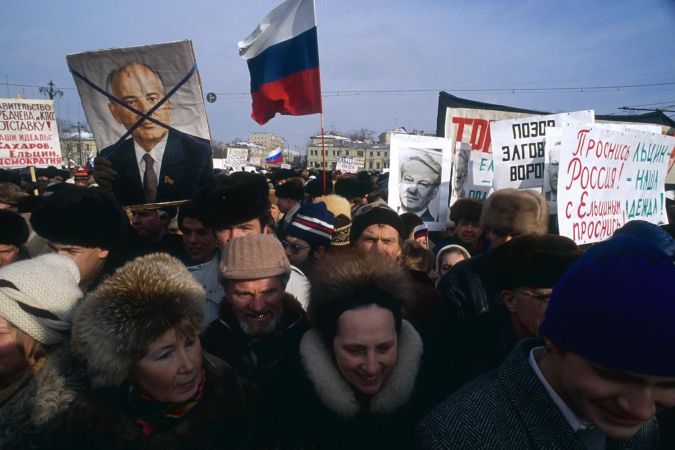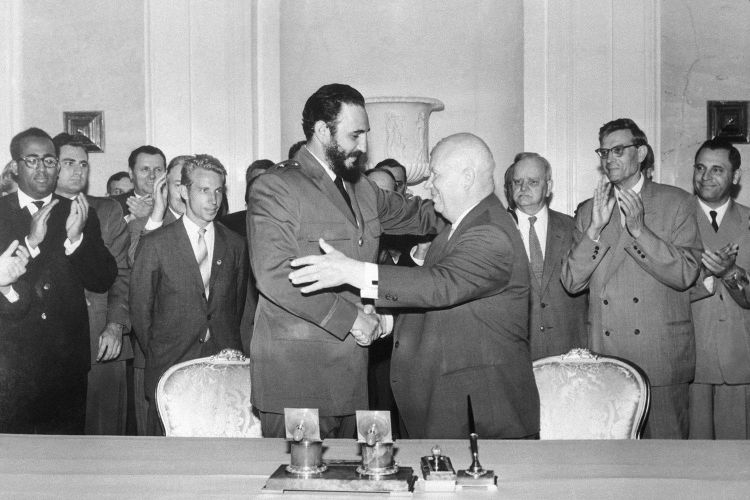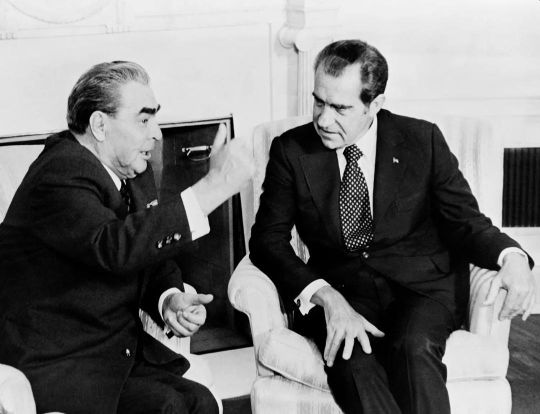By Eric Vandenbroeck and co-workers
To Run The World

For nearly a
half-century, there was a single factor, a single raison d’être, at the heart
of the entire Soviet project. But it wasn’t fanning the communist
revolution or even spreading Marxist Leninism itself. Rather, it was—as Sergey
Radchenko argues in To Run the World, his new, more than 600-page
doorstopper on
the Soviet leaders’ views during the Cold War—something far simpler, and far
more universal: prestige.
That is, instead of
pursuing anti-capitalist ends or even pro-communist alliances, Soviet
leadership found itself propelled primarily by the pursuit of status and
stature, from late Stalinism through Mikhail Gorbachev’s final days.
It’s a bold
reformulation of the entire Soviet standoff and one that would be nearly
unrecognizable to most of those who lived through the Cold War. But Radchenko,
a history professor at Johns Hopkins University specializing in Sino-Soviet
history, at least recognizes the stakes of such a reformulation.
He admits at the
outset of To Run the World that his argument is a “radical new
interpretation of the underlying motivations of Soviet foreign policy”—a
massive, almost encyclopedic effort to slog through the sloganeering about
Leninism and class warfare to get to what, at heart, motivated Soviet
leadership through the apocalyptic heights and sudden denouement of the Cold
War. Moscow believed “that the Soviet Union for one reason or another deserved its
high perch in the global order,” Radchenko writes. “Being recognized by
others as legitimately occupying this perch was a central preoccupation of
Soviet foreign policy from Stalin to Gorbachev.”
There’s certainly
merit to the argument, as Radchenko unflinchingly details throughout the book.
The product of a decade’s worth of work translating archival material in places
such as Moscow and Beijing, Radchenko’s read provides unparalleled insights into
the Soviet leadership’s decision-making processes. Not only has it surpassed
anything yet written, but given the archival access that Radchenko obtained—and
the fact that such access has disintegrated in the face of President
Vladimir Putin’s return to a totalitarian Russia.
And, in many ways,
rightfully so—though not necessarily for the reasons that Radchenko argued. The
book advances an argument about Soviet leaders’ political motivations. But if
anything, it is Radchenko’s psychological excavation of figures including Nikita
Khrushchev, Leonid Brezhnev, and Gorbachev
himself—their intentions,
their ignorance, their ignominies—that not only separates this book from any
others assessing Soviet strategy during the Cold War but also reframes the
entire Cold War itself.
Leaders Nikita
Khrushchev of the Soviet Union (right) and Fidel Castro of Cuba shake hands at
a meeting in Moscow, seen in 1963.

Not only was the Bay of Pigs fiasco fresh in Moscow’s minds, but
American influence and infiltration of the island also had, at that point, a
decades-long pedigree. In Khrushchev’s mind, shipping nuclear weapons to Cuba
was never about pressing Soviet advantages in the Caribbean—but about impeding
the United States’ pending reinvasion.
And in Khrushchev’s
mind, the gambit arguably succeeded. Not only did the Americans refrain from
any invasion redux, but Khrushchev convinced the
White House to
remove its Jupiter missiles from Turkey, restoring a semblance of parity to
both superpowers’ nuclear capabilities. Khrushchev’s gamesmanship may have
brought the world closer to a nuclear Armageddon than ever before (and
potentially after)—but, in many ways, it was a gamble that redounded to
Khrushchev’s benefit, at least in the short term. (Along the way, Radchenko
also makes sure to reinforce Khrushchev’s colorful, even off-kilter
communication, such as when he frothed to the Albanian defense minister, “You
will be spat at in the Soviet Union and you will drown in spit!”)
Of course,
Khrushchev’s blush with the apocalypse hardly assured others in the Kremlin
that he was the stabilizing force required for the era. An internal putsch soon
placed Brezhnev in power, and his so-called Brezhnev Doctrine brought a range
of the Soviet Union’s most striking victories, not least in thwarting reforms
in places such as Czechoslovakia.
But it is in widening
the Cold War’s aperture—moving far beyond the checkpoints in Berlin or the
tanks in Prague—that makes Radchenko’s work on Brezhnev stand out. Rather than
the stale, staid leader of memory, Brezhnev’s nimbleness as Soviet premier shines
through in his efforts in Asia, in relations with both Beijing and Hanoi.
Radchenko’s beat-by-beat navigation of Brezhnev’s tactical decisions in the
region, especially as the Vietnam War began splitting open, paints the Soviet
premier in a far more flattering light than he’s otherwise been remembered.
Outflanking both
China and the United States, Brezhnev saw arguably his greatest strategic
victory on the beaches and battlefields of South Vietnam, at least in terms of
expanding Soviet interests. (Not that the Americans necessarily made it
difficult; as a perplexed Brezhnev once said, “I just can’t figure it out: have
the Americans become so stupid that they can’t understand that bombs will not solve
the Vietnamese problem?”)
Soviet leader Leonid
Brezhnev (left) talks with U.S. President Richard Nixon at the White House in
Washington, D.C, on June 18, 1973.

Nor is it just
Brezhnev’s strategic successes that Radchenko recovers. It’s also his rote
racism—and how that racism, rampant among Soviet leadership, played a role in
the Sino-Soviet split. “Brezhnev’s depictions of China and the Chinese were
shockingly racist,” Radchenko writes, pointing to Brezhnev’s claims that the
Chinese were “treacherous,” “exceptionally sly,” and brimming with “perfidy”
and “hypocrisy.” At one point, Brezhnev—who freely claimed the Soviet Union was
a “European” country—claimed that Europe had the “most civilized society” in
the world. Small wonder that Chinese leader Mao Zedong, in whispers behind
Brezhnev’s back, would complain of Moscow’s tsarist-era annexations of swaths
of traditional Chinese territory. “We have yet to settle this bill with them,”
Mao menaced.
Brezhnev, of course,
eventually shriveled—both physically and mentally—while the Kremlin squandered
what geopolitical advantages it may have gained by its bungling into
Afghanistan. By the mid-1980s, it was clear that the Soviet project was failing
both within and without. Hence, the rise and reforms of Gorbachev—and, within a
few years, the dissolution of not only the Soviet empire but the Soviet Union
itself.
But as Radchenko
retraces Gorbachev’s faltering, he also presents as a useful corrective to
Western remembrances of Gorbachev’s leadership and his legacy. While the former
Soviet premier is broadly remembered, even celebrated, for a supposed aversion
to violence, Radchenko surfaces a wealth of evidence to the contrary. While
Gorbachev may have refrained from siccing tanks on protesters in Warsaw or
Bucharest, he nonetheless led bloodied crackdowns on the Soviet populace
itself, from Kazakhstan to Lithuania to Georgia, all in the name of shoring up the crumbling Soviet
edifice.
And while he never
went as far as his Chinese counterparts—not least Deng Xiaoping, who oversaw
the slaughter of thousands of protesters at Tiananmen Square—Gorbachev let any
pacifist mask slip when speaking about the Chinese crackdown. As Radchenko writes,
when “presented with the evidence that the [Chinese] army massacred 3,000
students in Beijing, Gorbachev privately remarked: ‘We must be realists. They,
like us, have to hold on. Three thousand… So what?’”
Radchenko’s
interventions, be they personal or political, are all welcome, deepening our
understanding of both the psychological and geopolitical contours of the Cold
War. But the question remains: Was prestige really at the heart of the Soviet
Union’s entire postwar project? The answer—disappointingly both for us and the
book—is: It depends.
There were, to be
sure, myriad instances in which prestige propelled the Kremlin’s decisions. The
search for stature, the almost pathetic pleading for respect as a superpower,
laces decisions ranging from Brezhnev’s calls for a Soviet-American “condominium”
overseeing global affairs to Gorbachev’s at-times-unilateral push for arms
reductions. But as the single force—as the central factor around which Soviet
officials organized their latticework of decisions—prestige falters.
Go back, for
instance, to the Cuban missile crisis mentioned above. While prestige may have
played a role in Khrushchev’s initial decisions—especially when it came to
wanting to be seen as the protector of nascent communist regimes in places such
as Cuba—the end of the crisis illustrated that security concerns would, in the
end, always trump prestige. Khrushchev ended the crisis with a clear tactical
success, forcing the Americans to stand down from housing nuclear weapons in
Turkey, strengthening Soviet security that much more. But the secrecy of
the deal’s details meant that Khrushchev’s supposed pursuit of
prestige was fatally undermined. Even Khrushchev recognized as much, with the
Soviet premier “acutely aware of the blow to his global prestige,” Radchenko
notes.
Or fast-forward a few
decades, as the walls closed in on a flailing Gorbachev. While the final Soviet
leader may have initially seen prestige as a foreign-policy motivator, by his latter years he’d clearly transformed into a figure who
gave equal, if not greater, weight to regime security Cracking down on
anti-regime protesters in a number of
colonies agitating for
independence, Gorbachev revealed himself as a leader happy to resort to
violence if the Soviet Union’s internal colonies ever agitated for
independence, regardless of the cost to his prestige in the West.
Still, while prestige
may not be the most important tether tying the entire Soviet project together,
Radchenko’s book does restore it to its proper place as one of a basket of
factors undergirding Soviet decision-making.
If anything,
elevating that search for prestige points the way to a far more interesting
book, buried underneath Radchenko’s granular psychoanalysis. As Radchenko aptly
frames, the Cold War was never one thing, catapulting one bloc against another.
It was never even something you could properly boil down to capitalism versus
communism. Rather, as Radchenko outlines, it’s perhaps better understood as
capitalism versus communism, with regimes such as Beijing and even
Havana charting their courses, refracting Soviet designs to pursue their paths—and
undercutting Soviet demands for prestige, and for recognition of status, in the
process.
After all, arguably
the single greatest Western success of the entire Cold War period—the Nixon
administration’s peeling-off of China, gutting any Soviet pretensions to
hegemony in Asia in the process—came as a direct result of Moscow’s pursuits of
both prestige and power. Without the Soviet demands that China, as Khrushchev
said, recognize the Kremlin as the “first fiddle” of the communist world, and
without concomitant tensions and outright violence playing out from the
Sino-Soviet border down to Vietnam, Beijing never would have considered
entreaties from the Americans. Thanks directly to the Soviet pretensions of
superpower status, Beijing dove directly into U.S. arms.
The Soviets were,
naturally, aghast at China’s lurch toward the United States. But that did
little to deter Moscow from continuing to pursue the same kinds of prestige and
power elsewhere—all of which, whether in the wastelands of Afghanistan or the
walls in Berlin, ended up decimating not only the Kremlin’s pretensions to
global status but imploding the Soviet Union as a whole.
Khrushchev may have
believed, perhaps correctly, that the Chinese were “haunted restlessly by the
mania of greatness.” But it was the Soviet Union that was haunted by a search
for both prestige and power—and that, in the end, ended up with neither.
For updates click hompage here